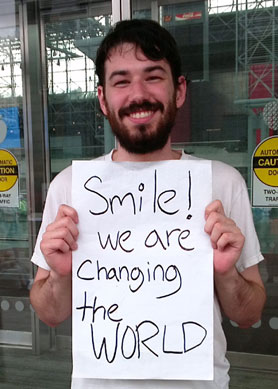For the second consecutive year, the world’s greenhouse gas emissions are flat!
Sure, it would be much better to report a big decline, but as I said last year, it really looks like the behemoth is beginning to turn.
Last year was the first to prove that energy-related emissions could remain flat while the economy grew, and this year confirms the trend.
"The new figures confirm last year’s surprising but welcome news: we now have seen two straight years of greenhouse gas emissions decoupling from economic growth," says Fatih Birol, Executive Director of the International Energy Agency (IEA). "Coming just a few months after the landmark COP21 agreement in Paris, this is yet another boost to the global fight against climate change."
Researchers predicted this emissions plateau.
For 2015, 32.1 billion tons of carbon were sent into the atmosphere, the same as 2014, as the world’s economy grew more than 3%, according to IEA.

Efficiency, Renewables Finally Play Role
The data also confirm that energy efficiency and renewable energy are finally growing to the point where their impact is being felt.
Accounting for 90% of all new electrical capacity in 2015, renewables are playing a critical role in keeping emissions down, says IEA.
Falling coal use, of course, is also a major factor. China’s emissions dropped 1.5% last year and in the US, they declined 2%. Unfortunately, this was countered by rising emissions elsewhere.
In the US, electricity demand is down, thanks to greater energy efficiency, says the US Energy Information Administration (EIA). This is the case in every sector: residential, commercial and industrial – a total of 1.1% for 2015.
Last year, industrial production was about the same as in 2007, for example, but electricity demand was 7% less, points out EIA. A transition to efficient lighting and HVAC has made the difference for the commercial and residential sectors.
Successful government policies are behind this positive change – standards that require efficient lighting and appliances.
Read our article, What’s Pushing Us Toward Greater Energy Efficiency?
The Next Step: Greatly Accelerate This Trend
Once carbon dioxide enters the atmosphere, it stays there for as much as 200 years. Emissions are up 60% since 1990, accumulating year after year.
If renewable energy doubles by 2030 – reaching 36% of the global energy mix – that will provide half the emissions cuts to keep temperature rise under 2°C, and energy efficiency can supply the other half, calculates the International Renewable Energy Agency (IRENA).
Doing this would also create over 24 million jobs and add 1.1% to world GDP, while saving up to $4.2 trillion a year on pollution that negatively affects human health and agriculture, says IRENA.
Under existing policies, the share of renewables is expected to reach only 21% by 2030. Another $290 billion a year would get us to 36%.
"Achieving a doubling is not only feasible, it is cheaper than not doing so," says Adnan Amin, Director General of IRENA.
You have probably heard that February was the hottest month ever, by far. At 1.35°C warmer than any other February, it shattered the previous record of 1.14°C in January, according to NASA. Parts of the Arctic were 16°C (29°F) above normal.
These figures are "stunning and completely unprecedented," says Stefan Rahmstorf of Germany’s Potsdam Institute of Climate Impact Research. "We are in a kind of climate emergency now."

